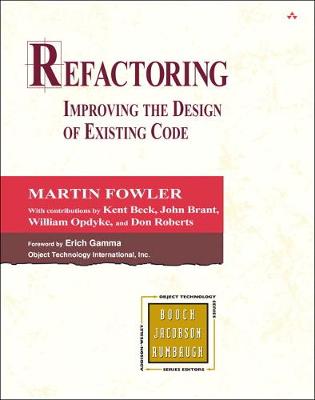Addison-Wesley Signature Series (Fowler)
3 total works
The practice of enterprise application development has benefited from the emergence of many new enabling technologies. Multi-tiered object-oriented platforms, such as Java and .NET, have become commonplace. These new tools and technologies are capable of building powerful applications, but they are not easily implemented. Common failures in enterprise applications often occur because their developers do not understand the architectural lessons that experienced object developers have learned.
Patterns of Enterprise Application Architecture is written in direct response to the stiff challenges that face enterprise application developers. The author, noted object-oriented designer Martin Fowler, noticed that despite changes in technology--from Smalltalk to CORBA to Java to .NET--the same basic design ideas can be adapted and applied to solve common problems. With the help of an expert group of contributors, Martin distills over forty recurring solutions into patterns. The result is an indispensable handbook of solutions that are applicable to any enterprise application platform.
This book is actually two books in one. The first section is a short tutorial on developing enterprise applications, which you can read from start to finish to understand the scope of the book's lessons. The next section, the bulk of the book, is a detailed reference to the patterns themselves. Each pattern provides usage and implementation information, as well as detailed code examples in Java or C#. The entire book is also richly illustrated with UML diagrams to further explain the concepts.
Armed with this book, you will have the knowledge necessary to make important architectural decisions about building an enterprise application and the proven patterns for use when building them.
The topics covered include
· Dividing an enterprise application into layers
· The major approaches to organizing business logic
· An in-depth treatment of mapping between objects and relational databases
· Using Model-View-Controller to organize a Web presentation
· Handling concurrency for data that spans multiple transactions
· Designing distributed object interfaces
As the application of object technology--particularly the Java programming language--has become commonplace, a new problem has emerged to confront the software development community. Significant numbers of poorly designed programs have been created by less-experienced developers, resulting in applications that are inefficient and hard to maintain and extend. Increasingly, software system professionals are discovering just how difficult it is to work with these inherited, "non-optimal" applications. For several years, expert-level object programmers have employed a growing collection of techniques to improve the structural integrity and performance of such existing software programs. Referred to as "refactoring," these practices have remained in the domain of experts because no attempt has been made to transcribe the lore into a form that all developers could use. . .until now. In Refactoring: Improving the Design of Existing Code, renowned object technology mentor Martin Fowler breaks new ground, demystifying these master practices and demonstrating how software practitioners can realize the significant benefits of this new process.
With proper training a skilled system designer can take a bad design and rework it into well-designed, robust code. In this book, Martin Fowler shows you where opportunities for refactoring typically can be found, and how to go about reworking a bad design into a good one. Each refactoring step is simple--seemingly too simple to be worth doing. Refactoring may involve moving a field from one class to another, or pulling some code out of a method to turn it into its own method, or even pushing some code up or down a hierarchy. While these individual steps may seem elementary, the cumulative effect of such small changes can radically improve the design. Refactoring is a proven way to prevent software decay.
In addition to discussing the various techniques of refactoring, the author provides a detailed catalog of more than seventy proven refactorings with helpful pointers that teach you when to apply them; step-by-step instructions for applying each refactoring; and an example illustrating how the refactoring works. The illustrative examples are written in Java, but the ideas are applicable to any object-oriented programming language.
When carefully selected and used, Domain-Specific Languages (DSLs) may simplify complex code, promote effective communication with customers, improve productivity, and unclog development bottlenecks. In Domain-Specific Languages, noted software development expert Martin Fowler first provides the information software professionals need to decide if and when to utilize DSLs. Then, where DSLs prove suitable, Fowler presents effective techniques for building them, and guides software engineers in choosing the right approaches for their applications.
This book’s techniques may be utilized with most modern object-oriented languages; the author provides numerous examples in Java and C#, as well as selected examples in Ruby. Wherever possible, chapters are organized to be self-standing, and most reference topics are presented in a familiar patterns format.
Armed with this wide-ranging book, developers will have the knowledge they need to make important decisions about DSLs—and, where appropriate, gain the significant technical and business benefits they offer.
The topics covered include:
- How DSLs compare to frameworks and libraries, and when those alternatives are sufficient
- Using parsers and parser generators, and parsing external DSLs
- Understanding, comparing, and choosing DSL language constructs
- Determining whether to use code generation, and comparing code generation strategies
- Previewing new language workbench tools for creating DSLs


